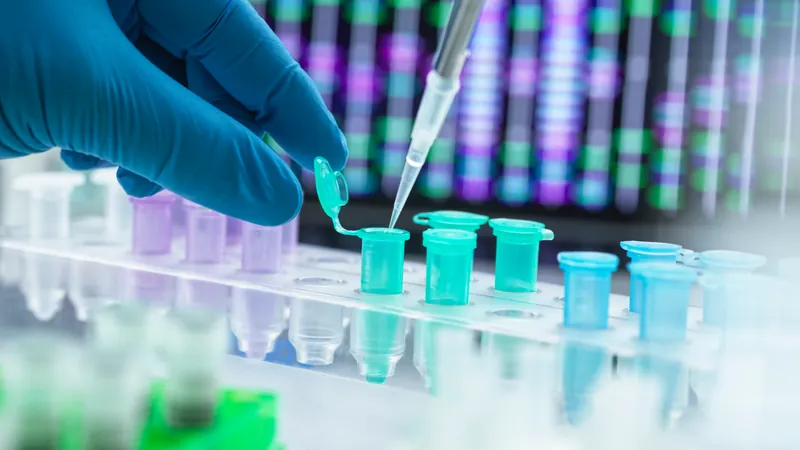
Revolutionary Fish Gut Bacteria Could Be the Secret Weapon Against Hyperpigmentation and Wrinkles!
2024-09-27
Author: Wei Ling
Introduction
Recent groundbreaking research from the American Chemical Society Omega has unveiled a potential game-changer in the world of skincare. Scientists at Sungkyunkwan University, under the leadership of Hyo-Jong Lee and Chung Sub Kim, discovered that certain compounds produced by gut bacteria from red seabream and blackhead seabream fish could effectively combat skin concerns like wrinkles and hyperpigmentation.
Research Findings
The researchers identified a total of 22 compounds derived from two specific bacteria—Ruegeria atlantica and Pseudoalteromonas neustonica. Remarkably, three of these compounds showed significant promise when tested on cultured mouse cells. They were found to inhibit two problematic enzymes, tyrosinase and collagenase, which are notorious for contributing to hyperpigmentation and skin aging, respectively.
Understanding the Mechanism: Taming Tyrosinase
Tyrosinase plays a critical role in melanin production, a process tied directly to skin coloration and age-related changes. The study noted, "Tyrosinase is essential in two critical stages of melanin synthesis." The highlighted compounds exhibited a 6.73% and 13.68% reduction in tyrosinase activity, suggesting they could help reduce unwanted pigmentation in human skin.
Defying Wrinkles by Controlling Collagen
The benefits don't stop at hyperpigmentation. The research indicated that compounds from these fish gut bacteria may also enhance collagen production, vital for maintaining skin elasticity and youthfulness. Two particularly potent compounds showed impressive inhibitory effects on collagenase, leading to a decrease in the breakdown of essential skin components.
Remarkable Resilience of Compound 11
Notably, compound 11—cyclo(l-Pro-d-Leu)—demonstrated durability, remaining effective under heat and UV light conditions. This resilience makes it a prime candidate for further development into a cosmeceutical with observable anti-aging properties.
A Surprising Source of Beauty
Fish gut bacteria may seem like an unconventional resource for skincare ingredients, but the history of medicinal discoveries tells us otherwise. While these bacteria were first isolated in past decades, this is the first substantial research into their therapeutic potential.
Potential for Innovative Skincare Products
The findings could pave the way for innovative skincare products targeting the aging process by harnessing compounds that inhibit collagenase and tyrosinase, promising a new era for cosmetic formulation.
The Vast Potential of Biological Sources
Moreover, the study underscores the vast potential for discovering new medication and cosmetic compounds from diverse biological sources. With approximately 98% of living organisms' metabolites still unidentified, the potential for breakthrough ingredients in both medicine and cosmetics is enormous.
The Future of Skin Care: A Natural Revolution
The shift toward utilizing natural ingredients in cosmetics is gaining momentum. A recent trend has seen the industry embrace pigments extracted from bacteria, fungi, and algae, presenting an eco-friendly alternative to synthetic compounds. Notably, microbial pigments have been reported as sustainable options for adding color to cosmetic products.
This research aligns with ongoing explorations into the use of traditional medicine ingredients, including mushrooms and other organic sources, for their complex biological benefits.
As scientists continue to investigate and refine these findings, the collaboration between biotechnological advances and beauty could open doors to revolutionary skincare products that not only prevent aging but also promote healthier skin.
Stay tuned as we uncover more about this exciting intersection of nature and beauty science—it could change the way we care for our skin forever!





 Brasil (PT)
Brasil (PT)
 Canada (EN)
Canada (EN)
 Chile (ES)
Chile (ES)
 Česko (CS)
Česko (CS)
 대한민국 (KO)
대한민국 (KO)
 España (ES)
España (ES)
 France (FR)
France (FR)
 Hong Kong (EN)
Hong Kong (EN)
 Italia (IT)
Italia (IT)
 日本 (JA)
日本 (JA)
 Magyarország (HU)
Magyarország (HU)
 Norge (NO)
Norge (NO)
 Polska (PL)
Polska (PL)
 Schweiz (DE)
Schweiz (DE)
 Singapore (EN)
Singapore (EN)
 Sverige (SV)
Sverige (SV)
 Suomi (FI)
Suomi (FI)
 Türkiye (TR)
Türkiye (TR)
 الإمارات العربية المتحدة (AR)
الإمارات العربية المتحدة (AR)